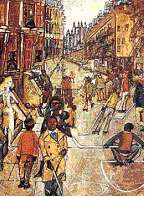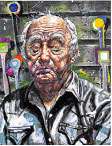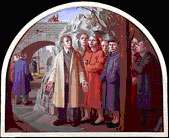Magic Realism

Magic Realism was the Style of painting inEurope and the USA mainly from the 1920s to 1940s, with some followers in the 1950s. It occupies a position between Surrealism and Photorealism, whereby the subject is rendered with a photographic naturalism, but where the use of flat tones, ambiguous perspectives and strange juxtapositions suggest an imagined or dreamed reality. The term was introduced by art historian Frank Roh in his bookNach-Expressionismus: Magischer Realismus (1925) to describe a style deriving from Neue Sachlichkeit, but rooted in late 19th-century German Romantic fantasy. It had strong connections with the Italian Pittura Metafisica of which the work of Giorgio de Chirico was exemplary in its quest to express the mysterious. The work of Giuseppe Capogrossi and the Scuola Romana of the 1930s is also closely related to the visionary elements of Magic Realism. In Belgium its surreal strand was exemplified by René Magritte, with his ‘fantasies of the commonplace’, and in the USA by Peter Blume, as inSouth ofScranton (1930–31; New York, Met.). Later artists associated with Magic Realism include the American George Tooker (b 1920), whose best-known work Subway (1950; New York, Whitney) captures the alienation of strangers gathered in public, and the German Christian Schad, who also used the style in the 1950s. The later use of the term for types of non-Western, particularly Latin American fiction was not connected with the artistic application.
Here is some information about the artist of this movement:
Ivan Le Lorriane
Albright, (1897-1983)Born in 1897 outside Chicago, both Ivan Le Lorraine Albright and his twin brother Malvin Marr Albright became artists, not a surprising development given that their father was a painter who gave his children middle names of artists he revered. The senior Albright's picturesque canvases were of less lasting value than his real estate investments, which offered a safety net for his sons as well as a life that included frequent travel. Ivan Albright's marriage in his forties to a cultivated socialite, Josephine Medill Patterson Reeve, brought additional security and the experience of parenthood.
Albright's artistic preoccupations changed little from the time he graduated from The Art Institute of Chicago in 1923 to his death sixty years later. The inexorable passage of time and the mortification of the flesh were his constant themes. Albright thought of himself as an individualist unrelated to contemporary art movements. He was deeply involved with the theory and craft of painting and opposed to the new currents of both abstraction and socially- engaged art that developed around him.
In the Butler Institute's self-portrait, and especially in others done at the very end of his life, he explored a highly traditional format that consciously refers to Francisco Goya, Rembrandt van Rijn, and even earlier to Raphael.
Albright had produced seven self-portraits in various media when he beganSelf Portrait inGeorgia, 1967, several months after his seventieth birthday.' His best known works were painted in the studio from close observation of elaborate arrangements of objects and models. This self-portrait, however, was painted outdoors, with the artist standing before the weathered clapboard of a studio he had built on his wife's Georgia plantation. It is a relentless investigation of his aging face. Few artists could have as eagerly anticipated growing old as much as Albright, for seeing in himself the evidence of aging was to personally experience his lifelong fascination with the mutability and decay of matter.

The self-portrait depicts a man both painfully resigned to death and staunchly proud of his life's accomplishment. 'All life is strong and powerful, even in the process of dissolution," he explained. This exploration of opposites within one work was the artist's conscious design; it creates a tension that keeps the image from becoming maudlin, a weakness Albright did not entirely avoid in his career.
Tooker, George (b. 1920) Although he was raised in a religious family, Tooker stopped attending church when he began art school. Nevertheless, the religious art of the past affected him deeply and has remained a major influence throughout his career. Speaking ofBird Watchers,he explained: "I wanted to paint a positive picture, a religious picture without religious subject matter. I thought watching birds was a good subject which could get close to a religious picture, but I was not yet ready to make a painting with a religious subject."
Based on quattrocento Italian prototypes,Bird Watchers suggests the Crucifixion, with the figures of Mary, Mary Magdalene, and the apostles and soldiers at the foot of the cross, which is represented by the tree to the right. The panel itself, with its arched top, refers to Renaissance altarpieces.

The painting is most likely set in Manhattan's Central Park. Although the figures are clearly from the late 1940s, Tooker removed all excess detail from their clothing in order to evoke a more timeless simplicity. For instance, the topcoat of the main figure has no buttons or buttonholes and becomes a loose robe of indeterminate style. The figures are monumental and stiffly posed, the composition stable and static, the faces, modeled for the most part on Tooker himself, his friends, and his family, standardized and repetitious. The use of primary colors enhances the painting's calmness and stability while also evoking Italian paintings. Moreover, the arched stone bridges and rocky outcroppings, while characteristic ofCentral Park, are simplified and stylized in the manner of Giotto and his contemporaries.
Paul Cadmus(1904-1999)Success came to Cadmus in 1933, when the U.S. Navy removed his painting "The Fleet's In!" from a highly publicized exhibition of WPA art at the Corcoran Gallery. The furor created by the censorship of this controversial painting depicting carousing sailors on shore leave brought Cadmus publicity and fame.
Since then, Cadmus consistently developed his own artistic vision. He created a small and coherent body of carefully wrought egg-tempera paintings and a large group of lyrical drawings of the nude male figure. His male nudes are fusions of Renaissance and what we might call modern domestic nudity.
Cadmus draws on toned paper. With graphite, he records the image before him in quick, short, parallel strokes. He is drawing shadows, technically — the areas on a back, or the creases on a neck or chin — that are not facing the source of light. The drawing is accurate, masterfully sensitive to the surface of the object drawn; and despite its being only a graph, moves toward a wholly convincing simulacrum of a shirt, a neck, a chin.
John Pence Gallery has long been an admirer of Cadmus, who has been instrumental in helping our gallery artists develop technique and style. Inquiries welcome.
Taken From:
http://www.artnet.com/library/05/0531/T053125.ASP http://www.nbmaa.org/Gallery_htmls/tooker.html#